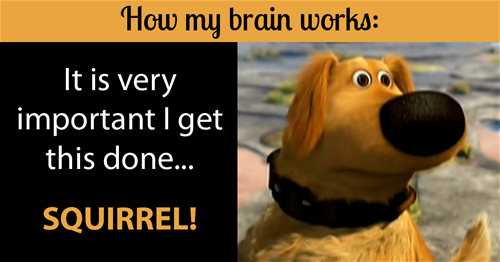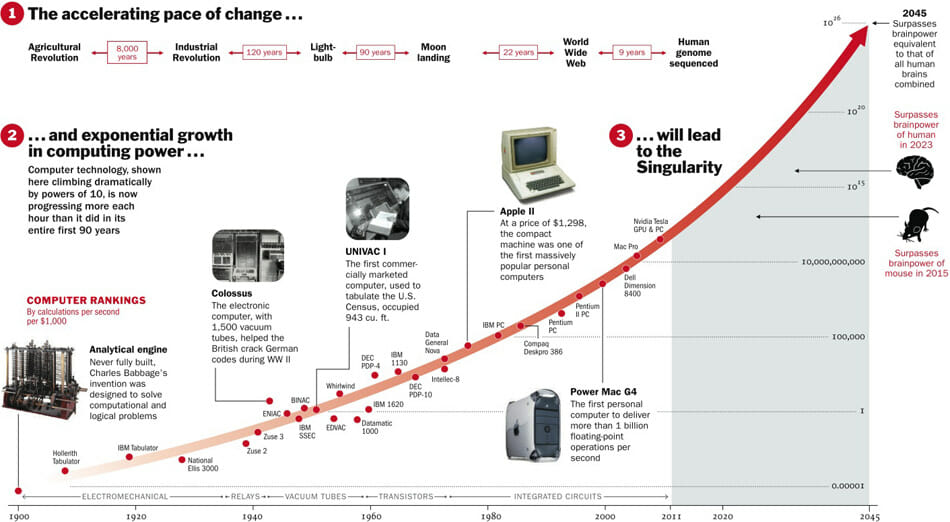
5 skills leaders will need to be successful in the future
Disruptive technology has dramatic implications for the skills leaders will need in the future. These 5 skills will help you navigate the noise of change.
The world is becoming more complex, and change is accelerating exponentially. Computer power, for example, as shown below, is now progressing more each hour than it did in its entire first 90 years, says Time.com.
There are predictions of coming “technological singularity” when everything changes so much that the future’s rules and technology are incomprehensible to previous generations. For example, imagine trying to explain the Internet to someone in the 1500s – they would have no concept or grasp of it. Futurists predict that artificial intelligence will create runaway advancements in technology, resulting in unfathomable changes in human civilization.
While this concept may feel far out, the potential technology disruption has dramatic implications for the skills we need to develop to be successful. As one of our clients put it, “We need to think in the future and act in the present.”
What do we need to do now to set ourselves and our teams up for success? I’ve been discussing these questions with clients, and above all else there are five main skills that they agree that their leaders need to have:
1. Learning agility
As the pace of change accelerates, only those that can respond to change gracefully with a learner’s mindset will succeed. As Eric Hoffer said, “In times of change, learners inherit the earth, while the learned find themselves beautifully equipped to deal with a world that no longer exists.”
Consider for example our software clients who grew up creating desktop on-premise software – they now need to shift create software for mobile and Internet of Things devices, which requires an entirely new mindset and skills. Their expertise, developed over decades of their career, became nearly useless.
The best-selling book Zen Mind, Beginner’s Mind by Shunryu Suzuki describes the importance of a learner’s mindset well: "In the beginner's mind there are many possibilities, but in the expert's there are few." When you are an expert, your brain (and, often, ego) is full. You don’t have space or curiosity to keep learning. And that means in times of change, you will quickly become irrelevant.
How do you develop “learning agility”?
Follow your natural curiosity. Imagine you are a child, exploring the world for the first time. What would you want to know more about? For example, a recent interviewee admitted, “I don’t know why but I recently got super into aquaponics. I’ve learned everything I can get my hands on in terms of the science, the chemistry, the plants, the water. It has no practical application but I had a blast.” That curiosity is exactly what we are looking for in candidates because it means they are agile enough to evolve as our industry evolves.
Questions to ask yourself:
- Do I rely on what I know or what I might learn?
- How easily do I drop my ego and admit I don’t know something?
- What am I naturally curious about?
2. Focused attention
We are living in a world with unprecedented stimuli. Your phone rings, your email pops up, a co-worker stops to chat, your calendar alerts you to a meeting - it’s madness. Most of the leaders I work with are in constant fire-fighting mode, responding to one urgent request after another, doing what is immediately available. This type of constant distraction without clarity creates stress, lost productivity, and ultimately burn out. This distraction creates a loss of control, and the only way to regain control is to learn to work with your mind to focus.
 In the movie Up, there is a dog that is constantly distracted by squirrels – “Squirrel!” – and his attention is immediately absorbed in the furry creature.
In the movie Up, there is a dog that is constantly distracted by squirrels – “Squirrel!” – and his attention is immediately absorbed in the furry creature.
We are the same way, unless we have learned to focus our attention. Attention is cultivated and grown like a muscle. There have been many books lately on prioritization and the essential few, which is great, but prioritizing only works if you have the disciplined attention to actually focus on the task at hand. In our fast-paced, instant-gratification world, we are strong on stimuli and weak on focused attention.
How do you develop “focused attention”?
Meditation. There are many types of meditation – I do a body-based meditation. My dad meditates while riding his dirt bike. My brother meditates by fixing RC cars. Whatever meditation works for you, the point is to focus all of your attention on one thing – your breath, your body, etc. Whenever your mind wanders, bring it back to the object of focus. Strengthening your attention muscle takes practice – hours, days, weeks, months, years. But the pay-off when you have the strength of mind to cut through the noise is worth it.
Questions to ask yourself:
- How well can I focus my attention?
- What am I doing today to cultivate and strengthen my attention? What could I be doing?
3. Lateral thinking
Also called creativity, innovation, fresh thinking, etc. Basically, leaders of the future need to be able to connect dots that haven’t been connected before in order to create new ideas. In our Innovation practice, one of our tools is to take two different concepts and fuse them together to see what new thing is created. For example – a cupcake and a car tire. Maybe you make a tire-shaped cupcake for tired mechanics? Or maybe you re-use the rubber from old tires to create oven-safe cupcake pans? The possibilities are endless. With more and more of our logical jobs being automated through technology, our biggest value-add as humans becomes our creativity and ability to think in surprising new ways.
How do you develop “lateral thinking”?
Play games like a child. When you are with friends, challenge yourselves to put two concepts together and draw links. Use word association. Open a dictionary to a random word and make up a story about that word. Explore dramatically different fields – mindfulness and dirt bikes, CrossFit and online education, Bikram and executive coaching – and see what common concepts you find between the fields. You can find more great ideas on developing your lateral thinking skills here.
Questions to ask yourself:
- How often do I let myself play like a child?
- Where can I explore next? How does X relate to Y?
- What area of my life could use some fresh ideas?
4. Radical interdependence
Adult development (also known as vertical development) describes the phases of maturity from dependence to independence to interdependence. At its essence, I see it as:
- Dependent people wait for a leader to tell them what to do
- Independent people create hierarchal guidance to execute a strategic plan
- Interdependent people facilitate common understanding between people
Interdependence is basically advanced collaboration. Every single company I work with says some version of “We need to work across the company more. We can’t just think about our own department” or “We collaborate but it is inefficient and a waste of time. We need to do smarter, more selective collaborative.” Building your ability to facilitate understanding and develop connections between people is critical for effective collaboration.
How do you develop “radical interdependence”?
Be the person in the group who helps creates shared understanding. Don’t wait for others to do so first, and don’t try to do solve it all by yourself then get others onboard, but rather see how you can facilitate a common vision and purpose for the group. Imagine yourself as a facilitator, not a leader or follower. One of my favorite reframes when I am in a group is to ask, “What are we solving for?” Once this is answered, then we can realign behind a common problem statement and create from there.
Questions to ask yourself:
- How do I feel about collaboration? Do I tend to go off and do work myself? Do I wait for the leader? Do I try to take charge?
- How well-networked am I currently?
- What would I need to do to build a stronger network?
5. Systems thinking
Everything you do creates a ripple effect. We are in a spider web, connected by invisible strings to every other person, place, and thing on the earth.
For example, when you take a bite of salad, you can think about the person that grew the lettuce in California, the one who labored to pick it, the machines that packaged it, the truck driver who drove it out to you, the store who refrigerated it, the cheerful counter person who sold it to you, the janitor who will take the empty plastic container out to the garbage bin, and more.
Leaders of the future need to be able to see these type of links and understand the broader implication of their decisions.
Companies are rapidly moving away from a traditional transactional relationship between the company and the customer towards an ecosystem partnership where they are collab-petitors (both competitors and collaborators). Consider Apple partnering with rivals Amazon and Google on a new AI study. While they are competitors in the mobile phone industry, they collaborate to advance the science of AI which could benefit them all. As the world gets more complex, the roles get blurry. A leader needs to have a vision for the company and see the broader system involved in order to understand the widespread impact of their decisions – on partners, on collab-petitors, on customers, on their supply chain, on the planet.
How do you develop “systems thinking”?
Ask for feedback on your impact. Until you can see it for yourself, you need to hear it from others so solicit feedback by using questions like “How did this decision impact your team?” or “What is your perspective on this situation?” When making a major decision, you can create a “system map” that draws out all the stakeholders that may be impacted by this decision. Consider the downstream implications of your decision – what would X or Y mean to all these people involved? No need to pander to others, but it is critical to consider the impact you want to have on the people and systems you are a part of.
Questions to ask yourself:
- What impact do I want to have on the people around me?
- How closely aligned are my actions with this desired impact?
- What can I do to better understand the system around me?
In summary, with the pace of change rapidly increasing, you can prepare yourself by developing your learning agility, focused attention, lateral thinking, radical interdependence, and systems perspective. Each of these skills will help you navigate the noise of change by having a broader perspective and ability to learn from others while thinking creatively about the future.
Infographic source: http://content.time.com/time/interactive/0,31813,2048601,00.html
This article also appears on BTS.com: The 5 Skills Leaders Need to Be Successful in the Future
 BTS, an Advantage Performance Group thought leader partner, is a global professional services firm headquartered in Stockholm, Sweden, with some 500 professionals in 33 offices located on six continents. We focus on the people side of strategy working with leaders at all levels to help them make better decisions, convert those decisions to actions and deliver results.
BTS, an Advantage Performance Group thought leader partner, is a global professional services firm headquartered in Stockholm, Sweden, with some 500 professionals in 33 offices located on six continents. We focus on the people side of strategy working with leaders at all levels to help them make better decisions, convert those decisions to actions and deliver results.
- 5 skills leaders will need to be successful in the future - August 24, 2017
- Why young people leave: A crisis of purpose for Millennials - July 26, 2017

